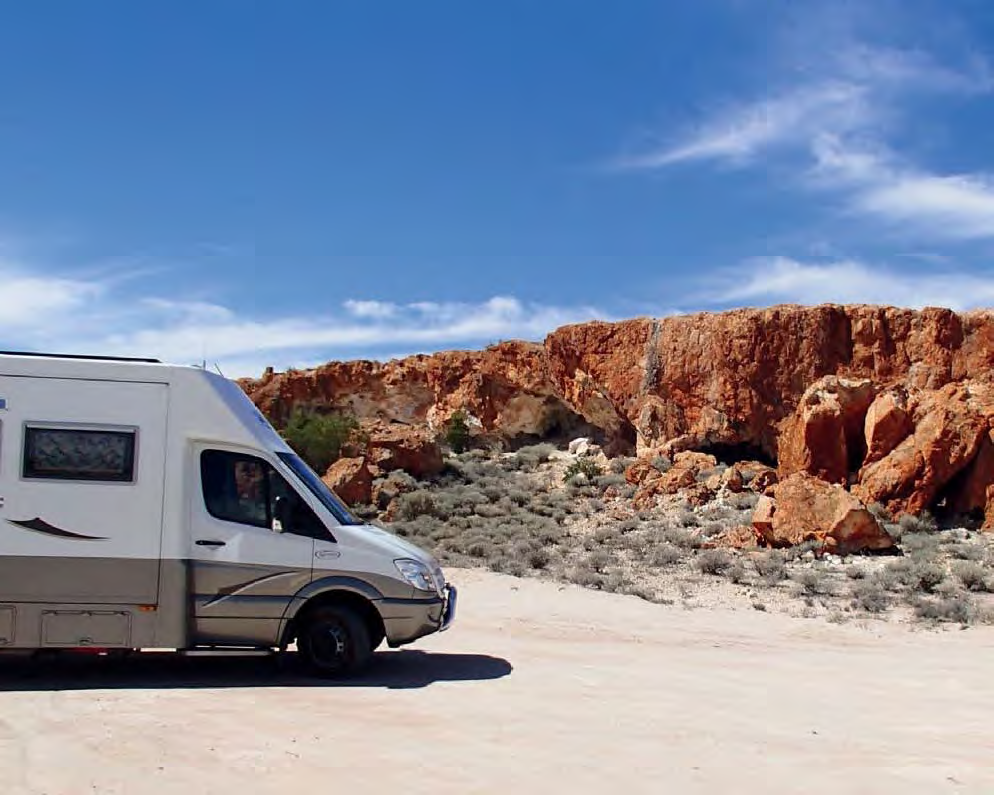
The Granites
After spending three months in and around the city of Perth with family and friends, we finally hauled in the anchor and headed along the Great Northern Highway, first stop, Bindoon Hill. The term ‘Hill’ should have indicated that it would not be a great overnight spot, with trucks winding up the Hill and stopping at all hours of the night. However, we were tired enough to not let the noise disturb our sleep.
New Norcia, just down the road, is Australia’s only monastic town and we had to stop to sample the most delicious gourmet bread baked in the monastery’s own 100 year old wood-fired oven. The ‘new’ flour mill, reputedly the oldest working flour mill in the state, was built in 1879. It is still operational and flour from the mill is used to produce the bread baked in the monastery’s ovens. The ‘old’ flour mill across the road dates from the 1850s and is the oldest surviving building in New Norcia.
The mission was founded in 1846 by two Benedictine monks, Dom Rosendo Salvado and Dom Joseph Serra. Their original vision was to create a largely self-sufficient village based on agriculture. However, after the decimation of the local Indigenous people from introduced diseases in the 1860s, Salvado concentrated on providing education for Indigenous children brought to New Norcia from all over the state. With the arrival of Dom Fulgentius Torres in 1901, there was a change of direction and New Norcia became more like a traditional monastic settlement. Torres established the mission as a centre of ecclesiastical art and culture. The library holds a great number of rare books, one volume dating back to 1508. Should you venture this way, we highly recommend taking the two hour guided tour. Pax, a Latin word meaning peace, is the motto of the Benedictine monks of New Norcia. It is the fruit of their regular, prayerful and stable life together and the gift they offer to all who visit their town.
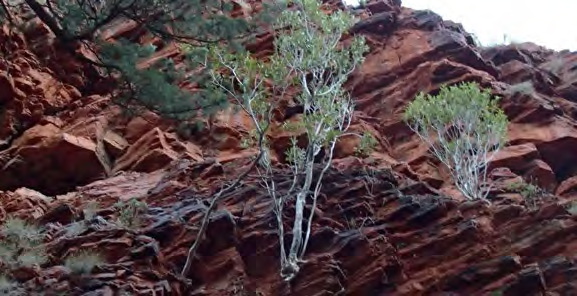
Mt Robinson Gorge
Paynes Find is considered the heart of the magnificent wildflower country in springtime, and we had a quick look at the gold mines here before finding a shady spot 12 kilometres further north where we were later surrounded by thunder storms.
Gold was discovered here in 1891 and the township of Mount Magnet was declared soon after. For over 100 years this has been a major mining centre and home to a sturdy pastoral industry, often through quite trying conditions. Today the shire of Mount Magnet is home to approximately 750 residents and 19 pastoral stations, some amongst the largest in the state.
Warramboo Lookout at Mount Magnet was our late breakfast stop next morning, giving us an overview of mining in the area. Armed with information we headed to The Granites, approximately nine kilometres north of town. Many years of natural erosion has resulted in these fascinating 15 metre high breakaways and caves. A place of strong cultural significance to the Badimia tribe, their old carvings and paintings are seen at several sites. Some of the paintings at Walganna Rocks have been dated at 9,000 years old. Within The Granites there is also a Gnamma Hole, a traditional native well covered by a stone.
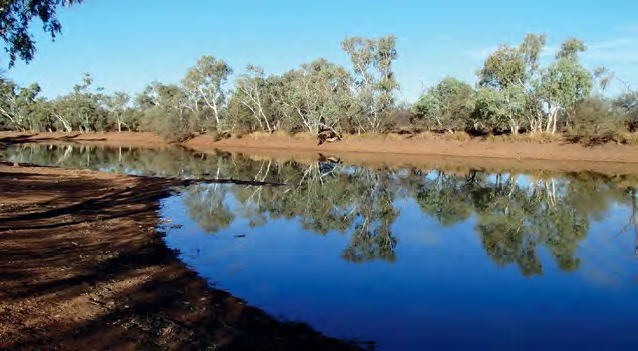
Taking a drive through the area and aware that the Driver was keen to stop so he could watch a car race on TV, I encouraged him to head to a flat spot to set up. However, the Driver thought he’d do the Navigator a favour and visit some more of the breakaways. He veered a sharp left and, oh my goodness, he was driving down a sandy creek bed which got narrower the further we went and there was no way we could stop for fear of getting bogged! The Navigator finally overcame the shock, navigating the Driver to where the road crossed the creek. We were back to a firm surface and it would be rude to repeat what the Navigator said during the hair-raising drive as the Driver clenched his teeth and prayed. He deserved to watch the car race after that little adventure and the Navigator wandered off to find a shady spot to cool off.
We continued the tourist drive to the railway siding and old town site of abandoned Lennonville. At its peak in the early 1900s it is believed that Lennonville was home to a population of 3,000, had five hotels and was the most important of Mount Magnet, Boogardie and Lennonville.
As we made our way to the cemetery the heavens opened up. The amphitheatre here is a unique rock formation, appearing to be an ancient waterfall from an older land level, a laterite capped island in space; one of those special places people say brings them closer to nature. It is here we stayed the night, listening to the rain pelting on the roof, accompanied by strong gusts of wind. But, luckily it all eased overnight and we awoke to a beautiful sunny morning. After climbing to the top of the ridge we drove to Lake Nallan, 20 kilometres north of Cue. We found one shady tree to park under whilst having lunch.
We continued on towards Meekatharra, stopping for the night at a rest area 19 kilometres out of town, opposite the Bluebird Gold Mine. At, affectionately named, Meeka, we walked to the lookout, drove to Peace Gorge for morning tea and then back to drive the Heritage Trail through town.
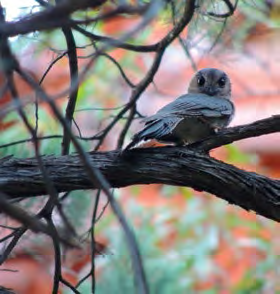
Lunch was at 27 Mile Well. A scrubby tree provided some shade and with all the windows open to catch any breeze, a willy-willy blew up from nowhere and covered every surface with red gritty sand, including the Driver’s freshly made salad!
Ninety kilometres north of Meekatharra and 14 kilometres west of the highway, we discovered Bilyuin Pool, one of a string of pools on the Murchison River that hold water in all but the driest season. This lovely spot is on a cattle property so the water is shared with the bovines. Apart from the birds and beasts we had the entire place to ourselves, declaring it a nature retreat. After three very peaceful days of rest we were ready to tackle the highway north once more. On the way to our next overnight spot at Middle Gascoyne River we stopped for morning tea beside the road where the Driver discovered a bird and called the Navigator to identify this unusual sight. It turned out to be a crested bellbird, one for the album.
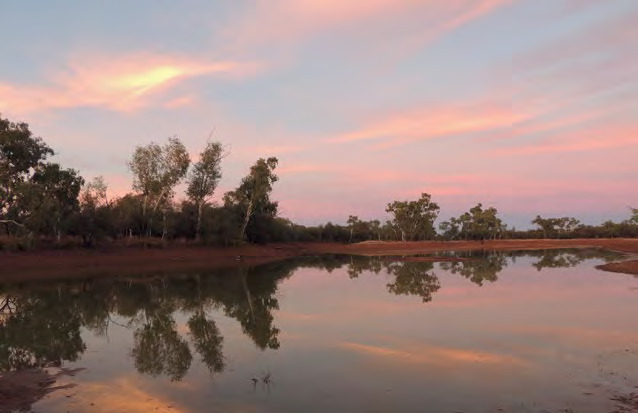
At Middle Gascoyne we were greeted by a pair of whistling kite birds, busily redesigning their nest, and lots of western bowerbirds. We had a pleasant camp spot beside the river here and the flies enjoyed our company immensely. Preparing to leave, the Driver almost blinded himself by accidentally putting ‘Aqua Ear’ in his right eye instead of the usual eye-drops. He looked like ‘Pirate Pete’ for a while.
At Newman we stayed at the Whaleback Village and booked for BHP Billiton’s Iron Ore Mine Tour. Newman is the largest modern mining town in the East Pilbara. The town takes its name from Mt Newman, a peak 1,055 metres above sea level. The mountain was named in 1896 after Aubrey Woodward Newman, an explorer on a mapping expedition who died of typhoid just before the project was completed. In 1957 a veteran prospector, A.S. Athol Stanley (Stan) Hilditch discovered a massive iron ore deposit. It was named Mt Whaleback as the hill resembled the shape of a humpback whale. It is now the world’s largest single open-cut iron ore mine.
The type of ore is Brockman Hematite which is 68.8% iron and blue grey in colour and is one of the highest grades in the world. Ore is blended to 65.1% using another ore called Goethite Limonite, which is 61% iron and ochre in colour. The ore from the satellite mines combined with the ore from Mt Whaleback produces two products called Newman Lump and Newman Fines. The Mt Whaleback seam is approximately 1.6 billion tonnes.
After three nights in a caravan park we were ready to ‘go bush’ again. Mt Robinson Rest Area was a scenic stop with a bonus gorge to explore. It was here that the Navigator fell in love with an Australian Owlet Nightjar. What a cute little bird and almost impossible to spot on the ground.
Next stop, Karijini National Park but that’s a story for another time.
Category: Unknown
Written: Tue 01 Oct 2013
Printed: October, 2013
Published By:
Doris Beal & John Langlois N9572